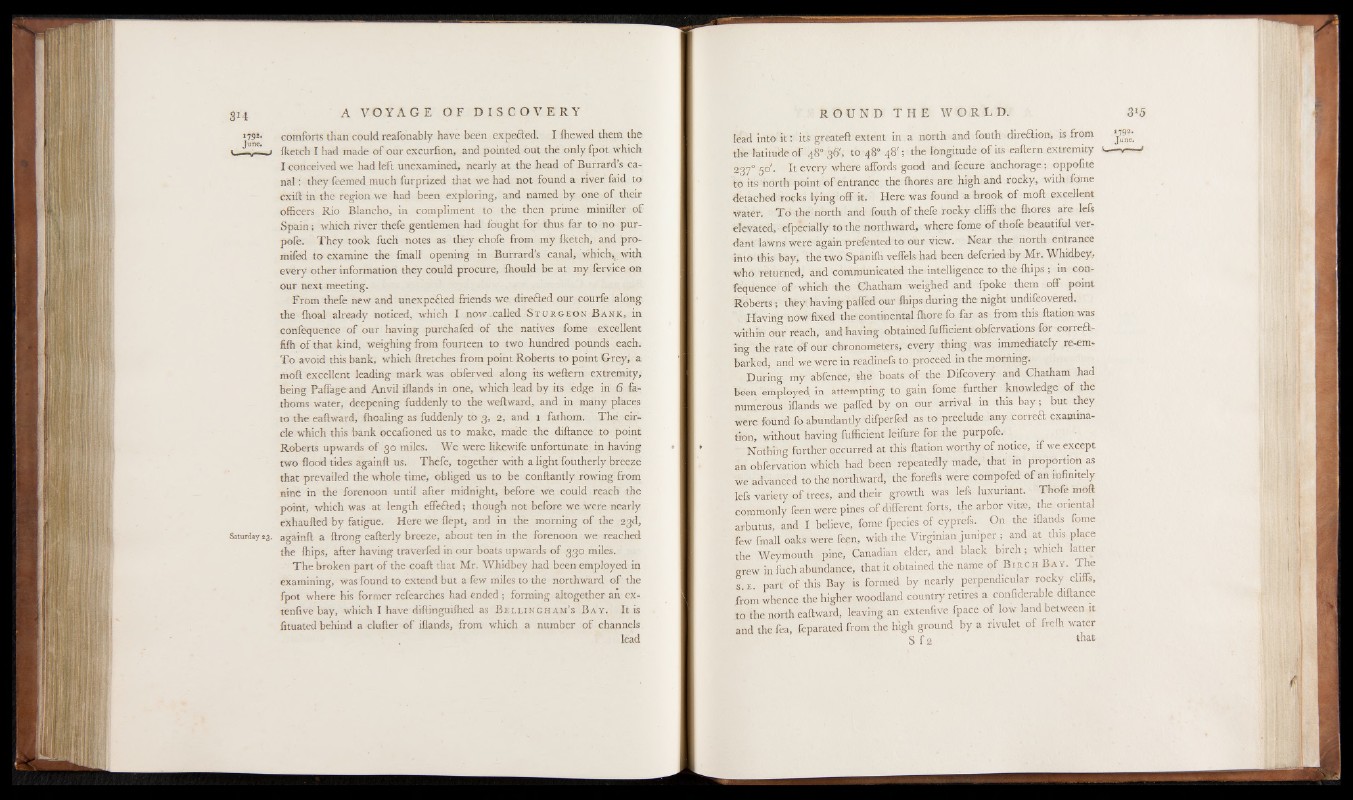
comforts than could reafonably have been expeöed. I Ihewed them the
{ketch I had made of our excurfion, and pointed out the only fpot which
I conceived we had left unexamined, nearly at the head of Burrard’s canal
: they feemed much furprized that we had not found a river faid to
exift in the region we had been exploring, and named by one of their
officers Rio Blancho, in compliment to the then prime minifler of
Spain; which river thefe gentlemen had fought for thus far to no pur-
pofe. They took fuch notes as they chofe from my fltetch, and pro-
mifed to examine the fmall opening in Burrard’s canal, which,t with
every other information they could procure, fhould be at my fervice on
our next meeting.
From thefe new and unexpefted friends we directed our courfe along
the fhoal already noticed, which I now.called S t u r g e o n B a n k , in
confequence o f our having purchafed of the natives fome excellent
filh of that kind, weighing from fourteen to two hundred pounds each.
To avoid this bank, which ftretches from point Roberts to point Grey, a
moft excellent leading mark was obferved along its weftem extremity,
being Paflage and Anvil iflands in one, which lead by its edge in 6 fathoms
water, deepening fuddenly to the weftward, and in many places
to the eaftward, fhoaling as fuddenly to g, 2, and 1 fathom. The circle
which this bank occafioned us to make, made the diftance to point
Roberts upwards o f go miles. We were likewife unfortunate in having
two flood tides againft us. Thefe, together with a fight foutherly breeze
that prevailed the whole time, obliged us to be conftantly rowing from
nine in the forenoon until after midnight, before we could reach the
point, which was at length effected; though not before we were nearly
exhaufted by fatigue. Here we flept, and in the morning o f the 23d,
Saturday 23. againft a ftrong eafterly breeze, about ten in the forenoon we reached
the {hips, after having traverfed in our boats upwards of g3o miles.
The broken part of the coaft that Mr. Whidbey had been employed in
examining, Was found to extend but a few miles to the northward of the
fpot where his former refearches had ended ; forming altogether an ex-
tenfive bay, which I have diftinguiftied as B e l l i n g h a m ’ s B a y . It is
fituated behind a duller o f iflands, from which a number of channels
lead
lead into i t : its greateft extent in a north and fouth direction, is from
the latitude of 48° 36', to 48“ 48'; the longitude of its eaftern extremity ---- -— -
237° 5°'- It every where affords good and fecure anchorage ; oppofite
to its north point o f entrance the fhores are high and rocky, with fome
detached rocks lying off it. Here was found a brook of moft excellent
water. To the north and fouth of thefe rocky cliffs the fhores are lefs
elevated, efpècially to the northward, where fome o f thofe beautiful verdant
lawns were again prefènted to our view. Near the north entrance
into this bay, the two Spanifh veflels had been defcried by Mr. Whidbey,
who returned, and communicated the intelligence to the fhips ; in confequence
of which the Chatham weighed and fpoke them off point
Roberts ; they having paffed our fhips during the night undifcovered.
Having now fixed the continental (hore fo far as from this ftalion was
within our reach, and having obtained fufficient obfervations for correft-
ing the rate of our chronometers, every thing was immediately re-embarked,
and we were in readinefs to proceed in the morning.
During my abfence, the boats of the Difcovery and Chatham had
been employed in attempting to gain fome further knowledge of the
numerous iflands we paffed by on our arrival in this b a y ; but they
were found fo abundantly difperfed as to preclude any correH examination,
without having fufficient leifure for the purpofe.
Nothing further occurred at this ftation worthy of notice, if we except
an obfervation which had been repeatedly made, that m proportion as
we advanced to the northward, the forefts were compofed of an infinitely
lefs variety of trees, and their growth was lefs luxuriant. Thofe moft
commonly feen were pines of different forts, the arbor vita, the oriental
arbutus, and I believe, fome fpecies of cyprefs. On the iflands fome
few fmall oaks were feen, with the Virginian juniper ; and at this place
the Weymouth pine, Canadian elder, and black birch; which latter
grew in fuch abundance, that it obtained the name of B i r c h B a y . The
s e part of this Bay is formed by nearly perpendicular rocky cliffs,
from whence the higher woodland country retires a considerable diftance
to the north eaftward, leaving an extenfive fpace of low land between it
and the fea, feparated from the high ground by a rivulet of frefh water
S f 2 that